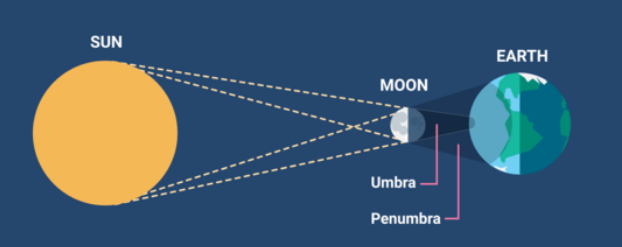Context :
A rare total solar eclipse crossed over North America on 8th April 2024.
More on News
- Only parts of the United States, Mexico and Canada witnessed a total solar eclipse.
- It is rare because it requires a precise alignment between the sun, moon, and Earth, according to NASA.
- On average, there can be two to five solar eclipses in a year. Total eclipses occur less frequently, with an interval of roughly 18 months.
- A specific location on Earth will experience a total solar eclipse very rarely, with an estimated recurrence time is once in 400 year.

what is a solar eclipse?
- Solar eclipses happen only at the New Moon when the three celestial bodies form a straight line: Earth–Moon–Sun. At the new moon, the Moon moves between Earth and the Sun and blocks the Sun’s rays from reaching some places on Earth. However, not every New Moon results in the solar eclipse.
There are three kinds of solar eclipses: total, partial, and annular.
- Total Solar Eclipse – A total solar eclipse occurs when the Moon completely covers the Sun, as seen from Earth. It can only be seen from a limited area, areas outside this track may be able to see a partial eclipse of the Sun.
- Partial Solar Eclipse – A partial solar eclipse happens when the Moon only partially covers the disk of the Sun.
- Annular Solar Eclipse – An annular solar eclipse occurs when the New Moon covers the Sun’s centre, leaving its outer edges to form a “ring of fire” or “annulus”.
- Hybrid Solar Eclipse – A hybrid solar eclipse is a rare form of a solar eclipse, which changes from an annular to a total solar eclipse, and vice versa, along its path.

Total solar eclipses
- This eclipse requires a precise alignment between the sun, moon, and Earth, blocking out the sun’s light and darkening the sky dramatically
- The limited area covered by the umbra, which is the darkest part of the Moon’s shadow, makes witnessing a total solar eclipse from a particular location a rare phenomenon, occurring over centuries.
- The umbral shadow is exceedingly small, covering less than one percent of Earth’s surface during a solar eclipse. Additionally, approximately 70 percent of the globe is covered by water, and half of the landmass is uninhabited. Hence, it is uncommon for a total solar eclipse to be visible to a large population.

